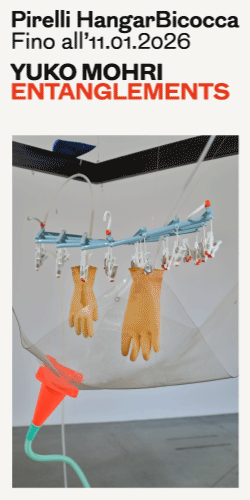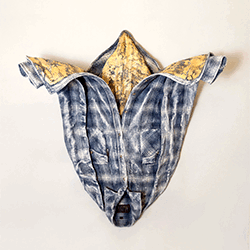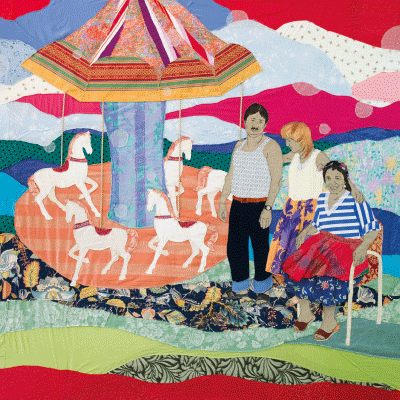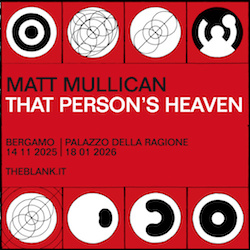
English version below
Justin Randolph Thompson è un artista, facilitatore culturale ed educatore nato a Peekskill, NY nel ’79. Vive tra l’Italia e gli Stati Uniti dal 1999. Thompson è co-fondatore e direttore del Black History Month Florence, un’esplorazione sfaccettata delle culture diasporiche africane e africane nel contesto dell’Italia fondata nel 2016.
Sara Benaglia: Chi è BHMF? Qual’è la vostra missione?
Justin Randolph Thompson: Black History Month Florence è stata fondata nel 2016 come rete istituzionale trasversale per la produzione culturale Black che celebra la diversità delle culture afro-discendenti nel contesto italiano. L’iniziativa è impegnata a programmare, consigliare e co-promuovere oltre 50 eventi ogni anno nel mese di febbraio, attraverso una rete formata e sostenuta dal Comune di Firenze, da fondazioni, istituzioni, associazioni culturali, musei, scuole e luoghi dedicati all’arte e alla musica.
Black History Month Florence si articola in BHMF Film, BHMF Arte, BHMF Laboratorio, BHMF Conferenze, BHMF Cucina, BHMF Tour, BHMF Bambini e BHMF Teatro/Danza formando una comunità che si dedica alla sfida di narrazioni appiattite sulle culture di culture africane e della diaspora africana e alla diffusione di una programmazione culturalmente diversificata. Presentata in una piattaforma singolare, l’iniziativa è un raduno di voci che mira a facilitare la ricerca e il dialogo interculturale.
SB: Come è stato pensato, come è nato The Recovery Plan?
JRT: The Recovery Plan è nato dal desiderio di spostare l’attenzione del nostro lavoro dal mese di febbraio per pensare a progetti che potevano essere sviluppati in modo costante e a lungo termine e alla ricerca in corso di cui c’era bisogno. È evidente il limite di relegare il nostro lavoro a un solo mese in un contesto culturale dove c’è un disperato bisogno di lavoro che generi nuove prospettive critiche, che affrontino il fatto che in Italia c’è sempre stata una presenza nera fin dalle prime storie registrate. Il progetto è stato sviluppato sulla base della creazione di un centro culturale nero a Firenze e quando la proposta di uno spazio fisico è stata accolta con indifferenza abbiamo deciso di istituirlo come forma di occupazione istituzionale pop-up. La prima edizione si è svolta presso la Fondazione Biagiotti con due mostre con le artiste Phoebe Boswell, Kelly Costigliolo, Rajkamal Kahlon, Adji Dieye, Alessandra Ferrini e Muna Mussie, oltre a una serie di eventi e workshop supportati da una biblioteca pop-up composta da libri prestati da vari studiosi. È nell’ambito di questa prima edizione che Simone Frangi ha suggerito di farne un pop-up altrove, come estensione della nostra rete. In sostanza, The Recovery Plan è il contenitore di tutto i progetti di ricerca in corso portati avanti da BHMF, con uno spazio che non è nostro se non nel periodo di occupazione.
SB: Le cinque mostre personali di Binta Diaw, Victor Fotso Nyie, Francis Offman, Raziel Perin, Emmanuel Yoro Gallagher al MAGA – Gallarate sono la fase finale di un articolato percorso di ricerca che ha coinvolto anche Simao Amista, Jordan Anderson, Angelica Pesarini, Jessica Sartiani, Patrick Joel Tatcheda Yonkeu, Alessandra Ferrini e Simone Frangi. Come avete strutturato questo percorso?
JRT: La serie di mostre personali in realtà non rappresenta la fase finale, ma un passo lungo il percorso di un progetto di lunga durata per sostenere e collettivizzare i giovani artisti afrodiscendenti nel paese. Il percorso è iniziato con la realizzazione della nostra prima edizione della YGBI Research Residency, che ha invitato i cinque artisti a trascorrere dieci giorni a Firenze presso lo Student Hotel, che ha fornito alloggio e aule per i nostri incontri, e con l’Ontario College of Art and Design, che ha messo a disposizione studi per lavorarare e mentori, i curatori internazionali Andrea Fatona e leaf jerlefia che hanno lavorato con gli artisti in questo periodo. L’obiettivo della residenza è di creare uno spazio nero di non performatività per potersi impegnare in un profondo scambio sulla diaspora. A questa residenza ha fatto seguito l’abbinamento di ogni artista con ricercatori afro-discendente per facilitare un dialogo e per formare una comunità allargata che li facesse riflettere insieme. La ricerca che ne è scaturita accompagna ogni mostra. Questa serie di progetti al Museo MA*GA è concepita come un progetto di ricerca nato dalla collaborazione con Simone Frangi e facilitato da Alessandro Castiglioni per realizzare mostre personali incorniciate istituzionalmente e per generare opere che faranno parte di una mostra collettiva che girerà in Italia e fuori dall’Italia portando questo gruppo di artisti in varie istituzioni con la cornice continuativa di The Recovery Plan. Contemporaneamente stiamo sviluppando la seconda edizione della YGBI Research Residency in collaborazione con Numeroventi a Firenze per il febbraio 2021 nell’ambito della sesta edizione di OSTINATO del BHMF.
SB: Non ci ricordiamo molti artisti italo-africani nell’arte contemporanea italiana. Perché c’è così tanta resistenza a mantenere lo sguardo bianco e il controllo sul campo?
JRT: Non c’è da meravigliarsi che questo accada vista la sua grande provincialità e la sua concezione della tradizione come qualcosa da salvaguardare e mantenere inalterato nel tempo (come se ciò fosse possibile). Per quasi quarant’anni il mondo dell’arte contemporanea è stato costantemente schiacciato da una svalutazione del lavoro artistico e dalla mancanza di rispetto verso l’arte come professione. Oltre a questo, un opportunismo crescente ha posto gli artisti in competizione tra loro piuttosto che come colleghi sul campo. Aggiungiamo a questo il razzismo, che ha una grande presenza nella società e che qui viene liquidato come una parte non significativa delle realtà vissute dell’Italia contemporanea, come se non fosse scritto nell’intera narrazione della storia e nella sua assegnazione di valori. In questo ambiente, essere artista significa praticare resistenza. Essere artisti neri in questo Paese significa confrontarsi con un consistente tentativo di appiattimento del proprio essere e della propria legittimità. Ciò avviene attraverso strutture curatoriali, norme istituzionali e un interesse turistico nel generare un romanticismo pieno di bellezza formale, ma svuotato delle schiaccianti realtà sociali che producono le opere. Fino a poco tempo fa non credo che gli artisti cercassero necessariamente di identificarsi come italo-africani o afro-italiani, qui c’erano certamente artisti neri, indipendentemente dal fatto che essi fossero canonizzati o meno. George Zogo è stato un grande esempio a Firenze. Lui ha lavorato in questo ambiente dagli anni ’70 fino alla sua morte nel 2016. In molti casi l’ambiente dell’arte ha spinto fuori molti artisti neri, così che essi hanno cercato rifugio e comunità altrove, in Francia, in Inghilterra, negli Stati Uniti o in molti altri luoghi che hanno un impegno e un rispetto diverso per gli artisti in generale e forse un senso di comunità più vibrante tra i popoli afrodiscendenti. Lo vediamo con molte giovani generazioni d’italiani neri che hanno cercato l’istruzione e alla fine anche la residenza altrove. Il nostro lavoro è in debito con tutti i pensatori e i creativi che ci hanno preceduto e che ci circondano oggi e la necessità di una resistenza collettiva è così forte che oggi non può più essere sopravvalutata.


SB: Nel 2015 la professoressa Deb Willis ha organizzato a Firenze il convegno internazionale BLACK PORTRAITURE{S} II: IMAGINING THE BLACK BODY AND RESTAGING “ORNAMENTAL BLACKNESS” IN HISTORY a Villa La Pietra. L’arte e la politica di rappresentare la nerezza hanno generato contesti di esame e di contestazione prima negli Stati Uniti e poi a livello globale. Questo discorso applicato alla cultura umanista è un tabù che continua ad essere sottovalutato in Italia? Ti faccio questa domanda pensando al tuo progetto On Being Present (2020) con Le Gallerie degli Uffizi.
JRT: Black Portraitures di Deb Willis e Henry Louis Gates Jr. e Re-Significations di Awam Amkpa e Ellyn Toscano sono stati davvero un momento incredibile se pensiamo che sono accaduti a Firenze. Il convegno è stato il culmine di alcuni anni di riflessione sulla nerezza in città e non solo, con molti studiosi e artisti coinvolti, e il suo impatto ha mandato scosse nella città, molte delle quali si sono trasformate in nuove opere e programmi. Il mio lavoro è stato parte della mostra che si è svolta tra il Museo Bardini, Villa La Pietra e la Galleria Biagiotti e ho presentato la mia ricerca nell’ambito del convegno. La stratificazione di queste riflessioni, radicata in una comprensione della storia che è transnazionale e che mette al centro la nerezza, è un aspetto importante che necessita di una maggiore esplorazione. Da un lato c’è un lamentarsi delle criticità nate in diversi contesti geo-storici che qui in Italia vengono applicati e dall’altro c’è un lamentarsi della mancanza di discorso e di linguaggio qui in Italia nei confronti della nerezza. Non credo che l’Umanesimo culturale sia un tabù in Italia. Sembra sottoscrivere il tessuto stesso delle narrazioni dominanti dell’italianità nella maggior parte delle istituzioni più importanti ed è dilagante in tutto il sistema educativo. Per me Black Portraitures ha aperto una porta al fatto che si trattava di conversazioni che potevano e dovevano svolgersi ovunque e la generale sottorappresentazione dei ricercatori e degli artisti italiani ha suscitato un’importante meditazione su tutto il lavoro da svolgere. Il progetto On Being Present riguarda la necessità di parlare di tutto ciò che è chiaramente presente nei nostri archivi e nelle nostre collezioni in Italia, ma che non è incluso nella narrazione storica di queste collezioni. Gli Uffizi rappresentano per molti versi gli scrittori, i custodi e i guardiani della storia dell’arte del Rinascimento italiano. Se, come istituzione, non sono coinvolti nella costante rinarrazione della storia e di ciò che la collezione rappresenta, allora la stessa storia viene raccontata più e più volte e i cancelli stessi rivelano la loro fragile costruzione.
SB: Come vedi il presente e il futuro degli studi decoloniali in Italia?
JRT: Gli studi decoloniali, o forse piuttosto studi post-coloniali, sono stati poco analizzati e sottovalutati nel contesto italiano e nell’ultimo decennio circa sono diventati sempre più una conversazione generalmente presente che è certamente un inizio. Non posso parlare degli studi e delle ricerche in ambito accademico in modo specifico, perché non è il mio campo, ma le riflessioni sulla storia coloniale italiana sono parte integrante del nostro programma annuale e delle nostre ricerche d’archivio in corso. Siamo interessati a facilitare questa ricerca tanto necessaria e a porre la necessità di maggiori prospettive alle istituzioni che salvaguardano e spesso perpetuano le storie coloniali. Siamo ugualmente interessati a spingere per un impegno serio e a lungo termine in questo discorso al di là del tokenismo che spesso viene ad esso applicato. Detto questo, penso che sia importante pensare al quadro di riferimento che vede l’Afrocentrismo o il lavoro che celebra la nerezza come lavoro de-coloniale o antirazzista. C’è un posizionamento della colonialità e del razzismo come istituzionalmente o socialmente neutrale o normativo che facilita la percezione che tutto ciò che non si allinea con queste opinioni sistemicamente violente sta lavorando contro di essa. Questo punto di vista deve essere reso instabile.
SB: State lavorando alla sesta edizione del Black History Month Florence e alla seconda edizione del Black History Month Bologna. Perché avete scelto il tema Ostinato e che cosa state preparando per questi eventi?
JRT: I nostri quadri tematici sono sempre inviti e critiche allo stesso tempo. Attingiamo al linguaggio che deriva dall’annotazione musicale come tattica per stratificare il significato nei nostri temi. Questo è un momento in cui, dopo cinque edizioni, ci siamo immaginati in un ambiente che si è evoluto, con partner istituzionali che ogni anno si assumono la piena responsabilità dell’organizzazione e del coordinamento dei loro eventi in programma come parte generale dei loro calendari. Abbiamo immaginato che i finanziamenti per il lavoro che stiamo facendo sarebbero diventati più presenti nel sostenere i nostri sforzi per resistere di contribuire al triste stato di cose in cui i lavoratori dell’arte e gli operatori culturali più in generale sono sottopagati se non sfruttati economicamente. In parte siamo arrivati a un punto in cui questo comincia a essere vero, ma in gran parte si tratta di obiettivi ancora non raggiunti. Ostinato è la caparbietà necessaria per continuare ad avanzare a testa alta verso la resistenza, deviando e rimodellando tutte le aggressioni che in modo piccolo e profondo generano ostacoli e che spesso vedono di scarsa rilevanza il nostro lavoro situato in Italia. È anche una critica all’ostinazione stessa delle tante istituzioni e dei tanti individui che si oppongono con fermezza a questo lavoro culturale. In musica Ostinato è una frase ripetuta che stabilisce il battito del cuore e la struttura che eleva le voci che vi si posano sopra. BHMF si impegna a generare la linea di basso, il backbeat che tiene in posizione la parte bassa, in modo che più voci possano improvvisare liberamente in cima. Abbiamo un ricco programma che si muoverà per il prossimo anno con un secondo volume di On Being Present con gli Uffizi, un secondo volume di YGBI Research Residency, lavoro tratto dal nostro terzo volume di Black Archive Alliance, un’incredibile lista di eventi virtuali e di persona con partner nuovi e passati che hanno unito le loro forze a Firenze e a Bologna, che vedono la necessità di questo lavoro soprattutto in un momento di distanzamento sociale e di chiusura nazionalistica e in un momento in cui la violenza inflitta ai corpi neri e le esclusioni messe in atto devono essere proattivamente e non solo reattivamente impegnate.


Interview with Justin Randolph Thompson
Sara Benaglia: Who is BHMF? Which is your mission?
Justin Randolph Thompson: Black History Month Florence was founded in 2016 as a cross institutional network for Black cultural production that celebrates the diversity of Afro-descendent cultures in the context of Italy. The initiative is engaged in programming, advising and co-promoting over 50 events annually within the month of February, through a network formed and supported by the Comune, foundations, institutions, cultural associations, museums, schools and venues dedicated to art and to music.
Black History Month Florence is broken down into BHMF Film, BHMF Art, BHMF Workshop, BHMF Talk, BHMF Food, BHMF Tours, BHMF Kids and BHMF Theatre/Dance forming a community dedicated to challenging flattened narratives about African and African Diasporic cultures and disseminating culturally diverse programming. Presented in a singular platform, the initiative is a rallying of voices designed to facilitate cross-cultural research and dialogue.
SB: How was The Recovery Plan thought/born?
JRT: The Recovery Plan was born out of a desire to shift the focus of our work away from the month of February and to think about longstanding projects that could be developed and ongoing research that was needed. The limitations of relegating our work to a single month in a cultural context where there is a dire need for work that is generative of new critical perspectives, that address the fact that there has always been a Black presence in Italy since the earliest recorded histories, is evident. The project was developed based on the creation of a Black cultural center in Florence and when the proposal for a physical space was met with indifference we decided to institute it as a pop-up form of institutional occupation. The first edition was held at Fondazione Biagiotti with two exhibitions including artists: Phoebe Boswell, Kelly Costigliolo, Rajkamal Kahlon, Adji Dieye, Alessandra Ferrini and Muna Mussie as well as a series of events and workshops supported by a pop-up library composed of books loaned to us from various scholars. It was in the context of this first edition that Simone Frangi suggested that it could pop-up elsewhere as an extension of our network. In essence, The Recovery Plan is the container for all of the ongoing research project of BHMF, holding space that is not ours except for in the period of occupation.
SB: The five solo shows of Binta Diaw, Victor Fotso Nyie, Francis Offman, Raziel Perin, Emmanuel Yoro Gallagher at MAGA – Gallarate are the final phase of a structured research path that involved Simao Amista, Jordan Anderson, Angelica Pesarini, Jessica Sartiani, Patrick Joel Tatcheda Yonkeu, Alessandra Ferrini and Simone Frangi too. How did you structure this path?
JRT: The series of solo exhibitions actually do not represent the final phase but a step along the path in a longstanding project to support and collectivize young Afrodescendent artists in the country. The path was initiated with the realization of our first edition of the YGBI Research Residency which invited the five artists to spend ten days in Florence hosted by The Student Hotel, which provided lodging and classrooms for our meetings, and with Ontario College of Art and Design, who provided studios and mentors in the form of international curators Andrea Fatona and leaf jerlefia who worked with the artists in this period. The objective of the residency is to create a Black space of non performativity in order to engage in a profound exchange about diaspora. This residency was followed up by the pairing of each artist with an Afro-descendent researcher in order to facilitate a dialogue and extended community for them to think together. The resulting research accompanies each of the exhibitions. This series of solo projects at the Museo MA*GA are designed as a research project born from a collaboration with Simone Frangi and facilitated by Alessandro Castiglioni to provide institutionally framed solo exhibitions and to generate the works that will be a part of a group exhibition which will tour in and beyond Italy bringing this group of artists to various institutions with the continued framework of The Recovery Plan. Simultaneously we are developing the second edition of the YGBI Research Residency in collaboration with Numeroventi in Florence for February 2021 within the framework of BHMF’s sixth edition OSTINATO.
SB: We don’t remember many italo-african artist in the italian contemporary art. Why is there so much resistance to keep a white gaze and control into the field?
JRT: We see this with many younger generations of Black Italians that have sought education and ultimately residence elsewhere. Our work is indebted to all thinkers and creatives that came before us and that surround us today and the need for collective resistance is so stark today it cannot be overstated. Italy is not an easy site for the formation of communities in general. With much provinciality and an understanding of tradition that posits it as something to be safeguarded and maintained unaltered in time( as if that is possible) it is no wonder. For nearly 40 years the contemporary art realm has been consistently crushed by a devaluing of artistic labor and the lack of respect towards art as a profession and along with that a rising opportunism that places each artist as if they were in competition with each other rather than as colleagues in the field. Add to this racism which has a large presence in society and which in Italy is dismissed as not a significant part of the lived realities of contemporary Italy, as if it was not written into the entire narration of history and its assignment of values. In this environment, to be an artist is to practice resistance. To be a Black artists in this country is to be confronted head on with a consistent attempt at flattening of your being and your legitimacy. This goes on through curatorial frameworks, institutional norms and a tourism based interest in generating romanticism that is full of formal beauty but evacuated of the crushing social realities that produce the work. Until fairly recently I don’t think that artists were necessarily seeking to identify as Italo-African or as Afro-Italian, there were certainly Black artists here whether they were canonized or not. George Zogo is a great example in Florence working in this environment from the 70’s through his death in 2016. In many cases the environment has pushed many Black artists out and they have sought sanctuary and community elsewhere, be it France, England or the US or any number of other sites that have a different engagement and respect for artists in general and perhaps a more vibrant sense of community amongst Afrodescendent peoples. We see this with many younger generations of Black Italians that have sought education and ultimately residence elsewhere. Our work is indebted to all thinkers and creatives that came before us and that surround us today and the need for collective resistance is so stark today it cannot be overstated.


SB: In 2015 professor Deb Willis organized in Florence the international conference BLACK PORTRAITURE{S} II: IMAGINING THE BLACK BODY AND RESTAGING “ORNAMENTAL BLACKNESS” IN HISTORY at Villa La Pietra. The art and politics of representing blackness have generated global sites of examination and contestation in the US first and globally then. Is this discourse applied to humanist culture a taboo that continues to be underestimated in Italy? I’m asking you this question thinking about your project On Being Present (2020) with Le Gallerie degli Uffizi.
JRT: Black Portraitures advanced by Dr. Deb Willis and Henry Louis Gates Jr. along with Re-Significations advanced by Awam Amkpa and Ellyn Toscano was truly an incredible moment to be in Florence. The conference was a culmination of a few years reflecting upon Blackness in the city and beyond with many scholars and artists involved and its impact has sent tremors into the city many of which has surfaced into new work and programming. My work was a part of the exhibition which was spread between Museo Bardini, Villa La Pietra and Galleria Biagiotti and I presented my research as a part of the conference. The layering of these reflections, rooted in an understanding of history that is transnational and that centers Blackness, is an important facet that needs more exploration. On the one hand there is a lament of criticalities born in different geo-historic contexts being applied here in Italy and on the other this is a lament of the lack of discourse and language here in regards to Blackness. I don’t think that cultural Humanism is a taboo in Italy. It seems to underwrite the very fabric of dominant narrations of Italianness across most of the more important institutions and is rampant throughout the educations system. For me Black Portraitures opened a door to the fact that these were conversations that could and should take place everywhere and the overall underrepresentation of Italian based scholarship and artists prompted and important meditation on all of the work that needs to be done. The project On Being Present is about the dire need to speak to all that is clearly present in our archives and collections in Italy but that are not included in the historical narration of these collections. In many ways the Uffizi represents the writers, keepers and guardians of the history of Italian Renaissance art. If, as an institution, they are not involved in the constant re-narrating of history and of what the collection represents than the same story is told over and over and the gates themselves reveal their fragile construction.
SB: How do you see the present and future of de-colonial studies in Italy?
JRT: There is a positioning of coloniality and of racism as institutionally or socially neutral or normative that facilitates the perception that anything that does not align with these systemically violent views is working against it. This vantage point needs to be unsettled. De-colonial studies or perhaps more Post-colonial studies have been under-examined and underappreciated in the context of Italy and in the past decade or so have become more and more a general conversation which is certainly a start. I cannot speak to the studies and research in academic environments specifically, as it is not my field but reflections on Italian colonial history are consistent parts of our annual program and our ongoing archive based research. We are interested in facilitating this much needed research and posing the need for more perspectives to institutions that safeguard and often perpetuate colonial histories. We are equally interested in pushing for serious and long term commitments to this discourse beyond tokenism that is often applied. That said, I think it is important to think about the framework that views Afrocentric or work that is celebratory of Blackness as de-colonial or anti-racist work. There is a positioning of coloniality and of racism as institutionally or socially neutral or normative that facilitates the perception that anything that does not align with these systemically violent views is working against it. This vantage point needs to be unsettled.
SB: You are working on the sixth edition of Black History Month Florence and the second edition of Black History Month Bologna. Why did you choose the theme Ostinato and what are you preparing for both events?
JRT: Our thematic frameworks are always invitations and critiques at the same time. We draw upon language that comes from musical notation as a way of layering meaning into our themes. This is a moment where, five editions later we imagined ourselves in an environment that moved itself forward with the institutional partners taking on full responsibility in the organization and coordination of their events in the program every year as a general part of their calendars. We imagined that funding for the work that we are doing would have become more present in supporting our efforts to resist contributing to the sad state of affairs where art workers and cultural workers more broadly are underpaid if not economically exploited. In part we have arrived at a point where this is beginning to be true but in large part these are still unfulfilled objectives. Ostinato is about the obstinacy that is required to keep moving head on into resistance deflecting and reshaping all of the aggressions that in small and profound ways are generative of obstacles and which often sees little relevance between our work and Italy. It is also a critique of the very obstinacy displayed by the many institutions and individuals who are steadfast in their opposition to this cultural work. In music Ostinato is a repeated phrase that provides the heartbeat and structure that elevates the voicings that are laid atop it. BHMF is committed to generating the bass line, the backbeat that holds the bottom end in place so that multiple voices can freely improvise atop. We have a rich program moving forth for next year with a second volume of On Being Present with the Uffizi, a second volume of YGBI Research Residency, work from our third volume of Black Archive Alliance, an incredible list of virtual and in person events with new and past partners who have joined forces in Florence and Bologna that see the need for this work above all in a moment of social distancing and nationalistic closures and in a moment where the violence inflicted on Black bodies and the exclusions enacted need to be proactively not just reactively engaged.










